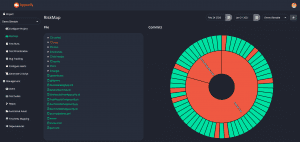Maps are good for lots of reasons
Living near Hollywood, I frequently pass stands selling Maps to the Stars. Being in QA testing, of course, what I’d rather have is a Map to the Bugs or Risk Map. Too bad that’s not possible.
Wouldn’t that be great, though? Open my map, drive a few blocks, and there’s a bug standing at the door waving to me. Okay, bugs don’t live in million dollar mansions and shop on Rodeo Drive. They hide inside the code, and we want to find them so we can stomp them, not take a selfie with them.
But without a map, how do we find them? Well… we can test everything. That was fine in the days when releases waited for QA to finish, but no longer. Now we have only a limited time to test as much as we can. So we have to be smarter about what we test.
We can talk to the devs. That’s a good start. They usually point us in the right direction, like the helpful guy at the gas station. But that takes time, and the developers sometimes, uh, forget to mention a few changes. Just the small changes, right? The kind that end up making a big mess. Hmm. That leaves our QA intuition; a.k.a guessing. That map would be really helpful, wouldn’t it?
Maybe there’s a way we can make that map after all. Let’s start by mapping the code structure and pinning all the changes to the right places. Then at least we’ll know which neighborhoods to check. If all the bugs are in Hollywood, there’s no point hunting in Beverly Hills for them.
Defect Risk Map
But we can do better. Because some commits are likelier to have bugs than others, aren’t they? Like the ones applied at 3 am. Or 5 minutes before a deadline. And all of Harold’s changes, because Harold never checks anything. And that file where lots of people are making changes at the same time—yeah, we’d better check that carefully, too. And that old spaghetti code that hasn’t been touched in ages? If someone is changing it now, they’re certain to screw up something.
So that QA intuition turns out to be more than just a guess, more like a sixth sense of what’s likely to break. But that takes experience. What about Irena who just joined last month, clicking on links randomly?
This is where Appsurify’s TestBrain comes in. It maps the commits to the code structure, then reviews the entire history of commits and defects to hone that bug sense. In minutes. So we actually can create that map that shows exactly which areas of the code are changed by the commits, along with the likelihood that the changes contain a bug. And voila, now we know exactly where to look for those pesky bugs. So we can prioritize our testing on the areas with the highest risks, and find more bugs faster. At the end of the day, we can take that selfie after all showing all the bugs we’ve quashed.
Risk Map is good for both Manual and Automated Testers

Appsurify RiskMap—your roadmap to the bugs. Interested in trying it out? Drop us a line, or sign up for a Free Trial.
Recently ranked on the QA Lead!
Read more at: Why TestBrain?
